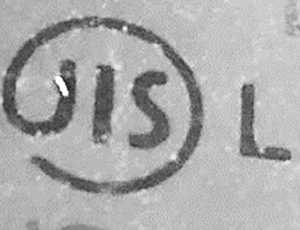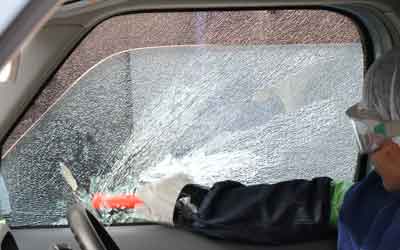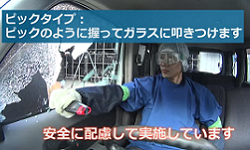Break car glass with emergency escape hammer in case of submersion! Prepare for flood
In recent years, it has been more frequently reported that roads were flooded due to heavy rain or river flooding and some passengers were trapped in submerged cars.
When a car is submerged to a certain degree underwater, it is difficult to open a door due to hydraulic pressure. Further flooding may cause electrical problems and may stop power windows from working. In addition, a door deformed due to a crash may not open. If a car is overturned, its seat belt is loaded by an occupant, which makes it difficult to unlock the seat belt.
When trapped inside a car, an emergency escape hammer for cars (hereafter called "emergency escape hammer") is useful for a passenger to cut seat belts and break door glass (glass for driver's door, assistant driver's door or backseat doors) or side glass (glass for sliding doors) to escape from a car. In 2012 and 2013, NCAC issued a consumer alert on some cutters which took much time to cut a seat belt and some hammers which were unable to break door glass.
Recently, an increasing number of car models use laminated glass for door glass to improve quietness. Such door glass is unbreakable with an emergency escape hammer.
Therefore, NCAC decided to conduct a questionnaire survey on use of emergency escape hammers and types of automotive glass and to test emergency escape hammers and seat belt cutters attached to emergency escape hammers. Based on the findings, NCAC would like to inform how to escape from a submerged car appropriately.
Emergency escape hammers
Emergency escape hammers are roughly divided into three types: T shape hammers (a user grips the bar during use); pick type hammers (a user grips the bar and uses like a pick); and punch type hammers (a user presses the pointed end firmly against glass). A seat belt cutter is attached to most of emergency escape hammers.
Automotive glass
Tempered glass
It's a type of glass which is hardened by thermal treatment, etc. When shattered, tempered glass breaks into particles and less likely to generate sharp fragments. Tempered glass is breakable with an emergency escape hammer. Tempered glass is mainly used for door glass, side glass and rear glass. JIS marked automotive tempered glass is marked "T" or "TP" next to the JIS mark.
Photo 1. Sample of a mark for tempered glass

Laminated glass
Laminated glass is made by pasting soft resin between two or more pieces of glass sheet. The interlayers work to support and hold the glass even when broken. Laminated glass is not easily pierced through. It's unbreakable with an emergency escape hammer. Laminated glass is always used for windshield of any car models. It is also used for door glass, side glass and rear glass of some car models. JIS marked automotive laminated glass is marked "L" or "LP" next to the JIS mark.
Photo 2. Sample of a mark for laminated glass

Questionnaire survey results
Consumer questionnaire (5,000 respondents)
Percentage of consumers who know emergency escape hammers and keep one in their cars
- Of those who know emergency escape hammers, about 20% keep an emergency escape hammer in their cars.
Where in the car it is kept
- Some respondents keep the tool where a driver cannot reach when wearing a seat belt and trapped inside a car (e.g. in the trunk).
Types of glass
- About 70% of the respondents don't know which type of glass is used for doors of their cars. About 40% of the respondents don't know that some types of glass are unbreakable with an emergency escape hammer.
Experience of using an emergency escape hammer
- Of those who know emergency escape hammers, 188 respondents have used an emergency escape hammer. Of the 188 respondents, 89 persons were unable to shatter glass with an emergency escape hammer for some reason.
Questionnaire to 11 companies manufacturing or selling the products tested
Performance of emergency escape hammers
- Three companies checked the performance with a test method in strict accordance with JIS D 5716.
Emergency escape hammers certified according to JIS
- Two companies answered that their emergency escape hammers had been certified according to JIS D 5716.
Questionnaire to 8 car manufacturers
Number of car models using laminated glass for doors
- Laminated glass was used for doors of about 20% of the car models to improve quietness.
How to escape in emergency
- Some companies advised consumers to act calmly when accidentally entering a flooded road.
Performance of emergency escape hammers
- Most companies checked the performance of emergency escape hammers by conducting JIS based tests or actual vehicle tests.
Test results
Cutting a seatbelt, breaking door glass
- Seat belts were cut and driver's door glass made of tempered glass was broken with any of the products tested.
Photo 3. Example of broken door glass (tempered glass)

Hardness test of the glass breaking protrusion
- Door glass was broken with any of the products tested, while hardness of the protrusion of one product was less than 760HV.
Cold and heat resistance test
- Deformation and cracks were seen in four products during the heat resistance test.
Labeling and representation
Labels on emergency escape hammers and attached holders
- The usage was labeled on main units of three products.
Description on packages and instruction manuals
- The usage and the recommended place to keep the tool were written on packages and manuals of all the products
Advice for consumers
- Do not enter a rapidly flooding or flooded road.1
- If your car is submerged, stay calm and try to unlock the seat belt and to open the door or window. If you cannot open a door/window or break door glass, wait until there will be no difference in water pressure inside and outside of your car so that you can open the door to escape.2
- Laminated glass, which is used for windshield of all car models and door glass of some car models, cannot be broken with an emergency escape hammer. Confirm which window glass of your car is breakable with an emergency escape hammer to prepare for emergency. If an emergency escape hammer can break window glass of your car, carry the hammer in your car.
- Choose a reliable emergency escape hammer with JIS mark.
- Choose an emergency escape hammer with a seat belt cutter. If a seat belt cutter is not attached, buy one.
- Safely place and secure an emergency escape hammer where a driver can reach when locked with a seat belt.
The following links are written in Japanese.
- 1 Dangerous when water level exceeds floorboard! Failures often occur when a car drives a flooded road (Ministry of Land, Infrastructure, Transport and Tourism)
- 2 Learn how to escape from a car before typhoon! Guide to escape from a submerged car and encouragement to keep an emergency escape hammer in a car (Ministry of Land, Infrastructure, Transport and Tourism)
Request to businesses
Request to companies manufacturing or selling emergency escape hammers
- Establish an industry association and seek to revise the JIS standard.
- Obtain JIS certification.
Request to car manufacturers
- Improve instruction manuals and keep consumers informed so that they can escape from a car in emergency. Let consumers know that laminated glass is used for doors if it is so.
Request to the government
Request to International Standardization Division, Industrial Science and Technology Policy and Environment Bureau, Ministry of Economy, Trade and Industry
- Promote the revision of the JIS.
- Encourage manufacturers to obtain JIS certification.
Request to Type Approval and Recall Division, Road Transport Bureau, Ministry of Land, Infrastructure, Transport and Tourism
- Encourage car manufacturers to ensure means of escape from a car in emergency.
- Encourage car manufacturers to take some measures so that consumers easily understand types of automotive glass when buying and using cars.

